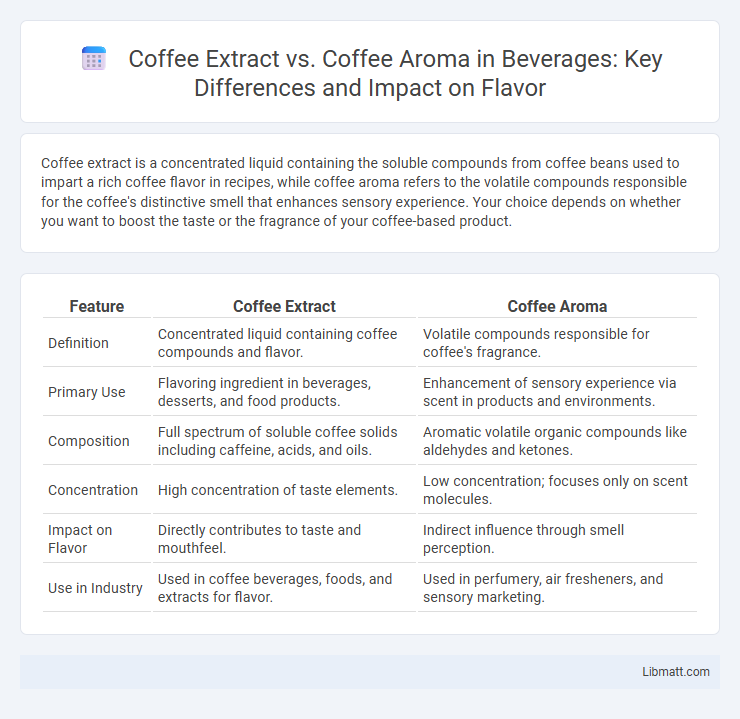Coffee extract is a concentrated liquid containing the soluble compounds from coffee beans used to impart a rich coffee flavor in recipes, while coffee aroma refers to the volatile compounds responsible for the coffee's distinctive smell that enhances sensory experience. Your choice depends on whether you want to boost the taste or the fragrance of your coffee-based product.
Table of Comparison
| Feature | Coffee Extract | Coffee Aroma |
|---|---|---|
| Definition | Concentrated liquid containing coffee compounds and flavor. | Volatile compounds responsible for coffee's fragrance. |
| Primary Use | Flavoring ingredient in beverages, desserts, and food products. | Enhancement of sensory experience via scent in products and environments. |
| Composition | Full spectrum of soluble coffee solids including caffeine, acids, and oils. | Aromatic volatile organic compounds like aldehydes and ketones. |
| Concentration | High concentration of taste elements. | Low concentration; focuses only on scent molecules. |
| Impact on Flavor | Directly contributes to taste and mouthfeel. | Indirect influence through smell perception. |
| Use in Industry | Used in coffee beverages, foods, and extracts for flavor. | Used in perfumery, air fresheners, and sensory marketing. |
Introduction to Coffee Extract and Coffee Aroma
Coffee extract is a concentrated liquid derived from brewing coffee beans, capturing their soluble flavors and caffeine content, widely used in beverages and flavorings. Coffee aroma, on the other hand, refers to the complex mixture of volatile compounds responsible for coffee's distinctive smell, significantly influencing sensory perception and quality assessment. Understanding the differences between coffee extract and coffee aroma helps you appreciate how each component contributes uniquely to the overall coffee experience.
What is Coffee Extract?
Coffee extract is a concentrated liquid derived from coffee beans, containing the key flavors, caffeine, and soluble compounds of the original coffee. It is produced by brewing ground coffee with solvents such as water, ethanol, or a combination, then filtering and reducing the liquid to enhance potency. Coffee extract is commonly used in food products, beverages, and flavorings to impart authentic coffee taste without the bulk of brewed coffee.
What is Coffee Aroma?
Coffee aroma refers to the complex scent profile released by coffee during brewing or roasting, consisting of over 800 volatile compounds that contribute to its distinctive smell. Unlike coffee extract, which contains soluble coffee solids and is used for flavoring or beverage preparation, coffee aroma is primarily the fragrance perceived through the olfactory senses. The intensity and character of coffee aroma significantly affect consumer appeal, influenced by factors such as bean origin, roasting level, and brewing method.
Composition Differences: Extract vs. Aroma
Coffee extract contains a concentrated mixture of soluble compounds like caffeine, chlorogenic acids, and antioxidants, providing the full flavor profile and health benefits of brewed coffee. Coffee aroma, on the other hand, consists primarily of volatile aromatic compounds such as aldehydes, ketones, and pyrazines that create the characteristic smell without the taste or bioactive substances. Understanding these composition differences helps you choose the right product for flavor enhancement or fragrance applications.
Production Methods: Extraction vs. Aromatization
Coffee extract is produced through extraction methods such as solvent extraction, supercritical CO2 extraction, or water-based extraction, which isolate concentrated flavors and bioactive compounds from roasted coffee beans. In contrast, coffee aroma is created through aromatization techniques, involving the capturing and recombining of volatile aromatic compounds often using steam distillation or headspace technology. Extraction focuses on solubilizing chemical constituents for use in beverages or food products, whereas aromatization emphasizes replicating the sensory experience of coffee scent.
Uses in Food and Beverages
Coffee extract serves as a concentrated flavoring in food products like baked goods, ice creams, and beverages, delivering a rich, robust coffee taste. Coffee aroma is primarily utilized to enhance the sensory experience in drinks such as lattes, cappuccinos, and flavored coffees, providing the characteristic coffee scent without altering the flavor intensity. Both forms play distinct roles, with coffee extract contributing to taste profiles and coffee aroma enhancing olfactory appeal in the food and beverage industry.
Flavor Profile Comparison
Coffee extract delivers a robust and concentrated flavor profile with rich, deep notes of roasted coffee, bitterness, and a hint of natural sweetness, making it ideal for enhancing the intensity of your beverage or recipe. In contrast, coffee aroma emphasizes the fragrant, volatile compounds that provide fresh, bright, and complex scent nuances, contributing primarily to the sensory experience without adding strong taste elements. Your choice between coffee extract and coffee aroma depends on whether you prioritize bold flavor intensity or aromatic depth in your culinary creations.
Health Benefits and Nutritional Value
Coffee extract contains concentrated bioactive compounds like chlorogenic acids and antioxidants that promote heart health, improve metabolism, and reduce inflammation. Coffee aroma, while less impactful nutritionally, enhances mood and cognitive function through olfactory stimulation and certain volatile compounds. Your choice between coffee extract and aroma depends on whether you prioritize tangible health benefits or sensory experience.
Shelf Life and Storage Considerations
Coffee extract typically has a longer shelf life than coffee aroma due to its concentrated form and preservative content, often lasting up to two years when stored in a cool, dark place. Coffee aroma, being more volatile and sensitive to air and light exposure, requires airtight containers and cooler temperatures to maintain its fragrance and usually lasts around six months to a year. Your storage method directly impacts the quality and longevity of both products, making proper sealing and temperature control essential.
Choosing the Right Option for Your Needs
Coffee extract delivers concentrated flavors and caffeine, ideal for recipes requiring robust taste and energy boost, while coffee aroma primarily enhances sensory appeal with its fragrance. Your choice depends on whether you prioritize flavor intensity or aromatic experience in your culinary or product application. Both options offer unique benefits tailored to enhancing coffee-related creations.
Coffee extract vs coffee aroma Infographic

 libmatt.com
libmatt.com